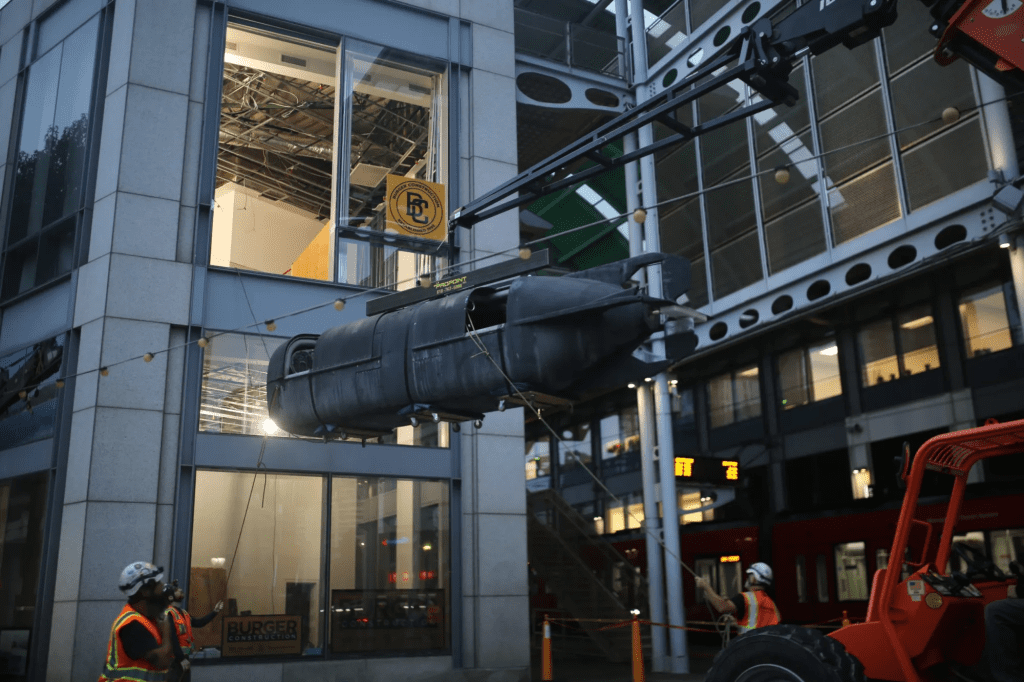The Navy SEAL Museum is set to open in the summer/fall of 2025, but they are starting to collect their exhibits and installations.

The sky over downtown San Diego is just starting to lighten as a crane lifts a large black submersible from the sidewalk, elevating it two stories in the air – and into the future Navy SEAL Museum.
The 22-foot-long submersible, designed to transport six combat-equipped sailors, is among the military relics to be featured in what used to be the Museum of Contemporary Art San Diego at 1001 Kettner Blvd.
The new SEAL museum is scheduled to open in the summer/fall of 2025, but organizers have been preparing its exhibits for years – this particular installation, for almost a decade.
The SEAL Delivery Vehicle
The submersibles, known as SEAL/Seal Delivery Vehicles (SDV), entered service in 1972 and have been used since then, with new models replacing older versions. Specimens are especially hard to find today, says Todd Perry, executive director of the museum, noting that curators had sought one for eight years.
Perry retired as a Navy captain in 2022 after serving as a SEAL for 40 years.
The retired SDV looks like a very large bullet, rounded and oval shaped. Its black hull has faded to gray and the insides and floors have been gutted, leaving just the controls of the submersible inside.
It’s a wet submarine, which means the sailors had to have their own oxygen equipment, or hook up to the vehicle’s oxygen supply as they performed their missions.



“You would ultimately launch this SDV from another platform, whether it be a surface ship or a sub,” says Charlie Matranga, a retired Navy SEAL who worked with SDVs for about eight years. “Either you’re going to go and do some sort of reconnaissance, or … you would take other individuals that might be in the back [of the SDV] and let them out. They’d go do their mission, and they would come back to you and everybody would recapture in the SDV and then go back to your other craft.”
Missions in the wet sub would take anywhere from 4-8 hours, with crew and passengers underwater the entire time.
Matranga learned how to pilot the vessels after he graduated from SEAL training in 1991. He piloted SDVs for six years and then became an instructor. He was a SEAL for a total of 26 years, and almost a third of his career was working with this model, known as the Mark 8, Mod 0.

It’s an incredible thing to have this wet sub in San Diego, Matranga says. “There hasn’t been an SDV presence in San Diego since about 1998.”
And the Navy SEAL museum is what finally brought the SDV back.
Perfect museum location
“I mean, just across the bay there, Coronado is where about 90% of SEALs kind of started. So, it’s great to be able to recapture all that … it’s great to be able to capture the heritage and the history of the SEAL delivery vehicles, and me being personally attached to the team,” Matranga says.
Perry has been waiting for years for the museum in San Diego to open, ever since the Navy UDT-SEAL Museum opened up in Fort Pierce, Florida in 1985.
“Fort Pierce is where our guys [were] originally trained for the Normandy landings, it’s very sacred ground for such an important museum,” Perry says. “But this is San Diego, right? Our SEALs are trained here, headquartered here, about half of them are here.”
Perry said current plans for the museum include 10,000 square feet of exhibit space, but he wants it to be even bigger – perhaps 50,000 square feet to fully tell the story of the Navy SEALs.

“This is such a great location,” Perry adds. “Kettner is one of the most prominent intersections in San Diego. There’s the Midway [Museum] right there, you can’t see the Maritime [Museum], but you know where that is … This is the place to have the museum,” Perry says.
He wants to tell the 80-year history of the SEALs in a location near where so many continue to train and operate today.
A third retired SEAL at the SDV installation, Brian Drechsler, says the mission of the museum is not only to preserve the culture and heritage, but to inspire others.
Drechsler was a SEAL for 26 years, retiring in June.
“It’s why we have that call to service wall at the end,” Drechsler says, referencing one of the exhibits. “We need recruits. But, hey, be a teacher. Be a law enforcement officer. Be a first responder. Be something bigger than yourself.”

The whole city waits quietly, mostly because it’s 6:30 in the morning, but the ones who are up and watching the SDV be lifted, feel like they are holding their breath.
The sky lightens as a crane elevates the submersible to the second story, and carefully rotates it – positioning the giant artifact perfectly to slide into place through a large, open window.
This wet submarine has been around since the 1980s, carrying hundreds of SEALs on countless missions. Now, the history and gravity of this will stay fixed in the air for thousands of people to marvel and wonder when the museum opens.


